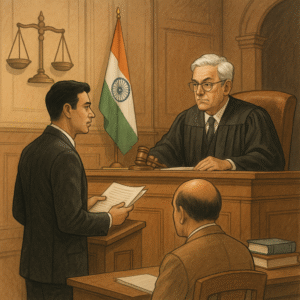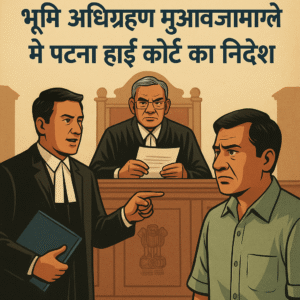Introduction
Justice delayed is often justice denied, but sometimes, the legal system takes a turn that restores faith in due process. This case, involving six men accused of murder in 1992 and convicted in 1995, was finally overturned by the Patna High Court in 2022, after 26 years of appeals and legal battles.
The case highlights critical flaws in the investigation, including unreliable dying declarations, lack of substantial evidence, and failure to establish a common intent among the accused. The judgment ultimately led to the acquittal of all appellants, reinforcing the legal principle that no one should be convicted without evidence beyond a reasonable doubt.
Background of the Case
The case revolves around the murder of Mokhtar, a resident of Gaya, Bihar, who was shot multiple times on November 23, 1992. According to the prosecution, he was attacked by a group of men while sitting in an open field. He allegedly ran towards his home and made a dying declaration, naming the attackers before succumbing to his injuries.
Based on this, the police arrested and charged the following individuals:
- Md. Rabbul Mian
- Md. Rakib alias Rakin
- Md. Jawed Mian
- Taiyab Mian
- Tahir Mian (deceased – appeal abated)
- Mokhtar Mian
The trial court in 1995 convicted them under Sections 302/34 of the Indian Penal Code (IPC) and sentenced them to life imprisonment. Additionally, Mokhtar Mian was convicted under the Arms Act and given three years of imprisonment.
Key Legal Arguments
Prosecution’s Case
- The deceased gave a dying declaration naming the accused before passing away.
- Witnesses, including family members, confirmed hearing gunshots and seeing the accused running from the scene.
- The post-mortem revealed three gunshot wounds, suggesting intentional homicide.
Defense’s Case
- No eyewitness directly saw the accused firing the gun; the case relied solely on the alleged dying declaration.
- The medical evidence contradicted the possibility that the deceased could have made a dying declaration due to injuries affecting his throat and vocal cords.
- The exact location of the crime was unclear, as two places were identified as crime scenes with inconsistent evidence.
- No concrete evidence of common intention among the accused was provided.
Major Issues Considered by the Court
1. Uncertainty About the Crime Scene
The prosecution presented two different places as the crime scene:
- An open field owned by Khalil Mian (where the attack allegedly began).
- A lane near the house of Aleem Mian (where the deceased supposedly collapsed).
The Investigating Officer (IO) admitted that no bloodstains, bullet casings, or forensic evidence were found in the field, casting doubt on the initial claim.
At the second location, an empty bullet casing and a live round were found, but no eyewitness confirmed that the deceased was shot there.
The court ruled that without a clearly established crime scene, the prosecution’s case was unreliable.
2. Reliability of the Dying Declaration
The prosecution claimed that before dying, the victim clearly named his attackers. However, the post-mortem report contradicted this:
- The doctor stated that one bullet hit the throat and vocal cords, making it nearly impossible for the victim to speak clearly.
- The court noted that the prosecution failed to mention if the victim spoke in an unclear voice, which would have supported the medical findings.
- The exact words of the dying declaration were never recorded in the FIR, reducing its evidentiary value.
The court ruled that the dying declaration could not be trusted as decisive evidence.
3. Lack of Evidence of Common Intention
The accused were convicted under Section 302/34 IPC, which requires proof that they acted with a shared intention to commit murder.
- However, no witness testified that all accused were seen together planning or executing the crime.
- Three accused were only seen running away from the crime scene, but this did not prove they participated in the killing.
- The court ruled that the prosecution failed to establish a joint intent, making the conviction under Section 34 IPC invalid.
4. Contradictions in Witness Testimonies
- A key witness (PW6), who was present at the scene, said he heard gunshots but did not see who fired them.
- Another witness (PW7, the victim’s mother) claimed to be present when the dying declaration was made. However, PW6 stated that only the informant (PW11) was there.
The court ruled that these contradictions further weakened the prosecution’s case.
The High Court’s Final Judgment
Based on these issues, the Patna High Court overturned the convictions and acquitted all accused, ruling that:
- The prosecution failed to prove the crime scene beyond a reasonable doubt.
- The dying declaration was unreliable due to medical contradictions.
- No concrete evidence linked all accused in a common intent to murder.
- The trial court had convicted the accused without strong legal grounds.
The judgment and sentence from 1995 were set aside, and since the accused were on bail, they were freed from all legal obligations.
Broader Implications of the Case
1. Importance of Medical Evidence in Dying Declarations
The case reinforces the legal principle that dying declarations must align with medical evidence. If injuries make speech impossible, the declaration cannot be considered valid.
2. The Need for Clear Crime Scene Evidence
Proving the exact location of the crime is crucial. Inconsistent locations weaken the prosecution’s case and create reasonable doubt.
3. Strengthening the Standard for Convictions Under Section 34 IPC
The ruling highlights that mere presence or association is not enough to prove “common intention”. Prosecution must show active participation in planning and execution.
4. Delays in the Judicial System
The case took 26 years to reach its final verdict, reflecting the slow pace of India’s judicial system. This long wait denied the accused the right to a speedy trial.
Conclusion: Justice, Though Delayed, Was Finally Served
This case is a classic example of how wrongful convictions can happen due to weak evidence, procedural lapses, and unreliable witness accounts. After decades of legal struggle, the accused were finally acquitted, proving that the principle of “innocent until proven guilty” must always prevail.
The ruling sends a strong message about the importance of due process and fair trials, ensuring that no person is unjustly punished without clear and convincing evidence.
Read
the full judgement Below;
https://patnahighcourt.gov.in/viewjudgment/NSM2IzE5OTYjMSNO-iZbDIy3SBuQ=







